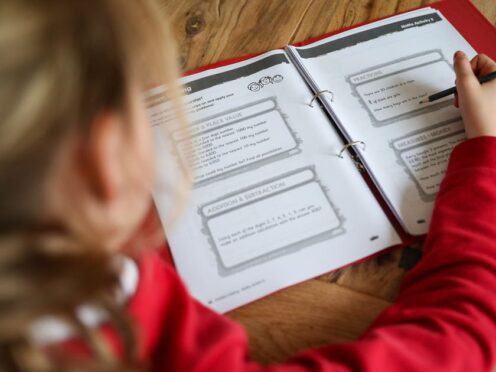More than 90,000 children were estimated to be in home education in the autumn term – a rise on the previous year, Government figures suggest.
Estimates by the Department for Education (DfE) suggest 92,000 children were in elective home education (EHE) at the census date in autumn last year, compared with 80,900 children in autumn 2022.
The figures come after an investigation by the PA news agency found that dozens of councils in England have seen a sharp rise in the number of children in EHE since the Covid-19 pandemic.
The DfE data – reported by local authorities in England on a single day – estimates that the number of children known to be in home education in the autumn term was lower than in the summer term.
An estimated 97,600 children were reported to be in EHE in summer 2023, compared with an estimated 86,200 children in the spring term of 2023.
During the 2022/23 academic year, an estimated 126,100 children were known to be in home education at any point, compared with an estimated 116,300 during the 2021/22 academic year, the new figures suggest.
It comes after councils told PA that more families have opted to formally remove their children from school after the pandemic allowed them to experience homeschooling.
A growing number of parents are also now educating their children at home because they feel the current school system cannot meet their needs, according to home education charity Education Otherwise.
The DfE also published data on the number of children missing education (CME) in England which suggests this cohort has also increased.
These children are of compulsory school age who are not registered pupils at a school and are not receiving suitable education otherwise than at a school.
There were an estimated 33,000 children missing education as of the census date in autumn 2023, compared with an estimated 24,700 in the previous autumn term, the DfE data suggests.
During the 2022/23 academic year, there were an estimated 117,100 children missing education at any point, compared with an estimated 94,900 in 2021/22.
Politicians, council leaders and headteachers’ unions have been calling for a national register of children not in school to ensure local authorities know how many young people are being educated at home, but many home educators oppose a register as they fear it could lead to greater interference.
Geoff Barton, general secretary of the Association of School and College Leaders (ASCL), said: “We are concerned that the increase in elective home education is in part a symptom of wider problems – such as unmet special education needs, and school anxiety and other mental health issues.
“These are areas that are badly under-resourced with huge pressures on school funding and an erosion in local support services.”
He added: “Alongside this is a rise in the estimated number of children missing education which once again emphasises the need for a mandatory national register of children not in school – something which the government keeps failing to do.
“If we do not even know exactly who is missing out on education, we cannot begin to understand the reasons for this and provide them with the support they need to return to school.”
Proposals to legislate for a new national register of children not in school were once part of the Government’s now-scrapped Schools Bill.
Last month, Labour said it would introduce a national register of children who are not in school if the party wins power at the next general election.
The DfE has previously said it is “working closely” with Flick Drummond, Tory MP for Meon Valley, on The Children Not in School Bill – which is currently progressing through Parliament and will “aim to create legal duties on local authorities to maintain such registers”.
Wendy Charles-Warner, chair of Education Otherwise, said: “The smoke and mirrors of persistent othering of home-educating families and repeated demands to regulate, monitor and straightjacket home education, increasingly appear to be distractions from the real issue of failure to give parents a genuine ability to choose good quality education within the school system.
“This is particularly so for our most vulnerable children, those with special needs and those with mental health issues.”
Heather Sandy, chair of the education policy committee of the Association of Directors of Children’s Services (ADCS), called the figures “stark”.
She said: “We recognise that parents have the right to educate their children at home and that it can be a positive experience, however, we know that for some children this is not the case, yet LAs (local authorities) lack the necessary powers to assure themselves that these children are safe and receiving a suitable education.”
